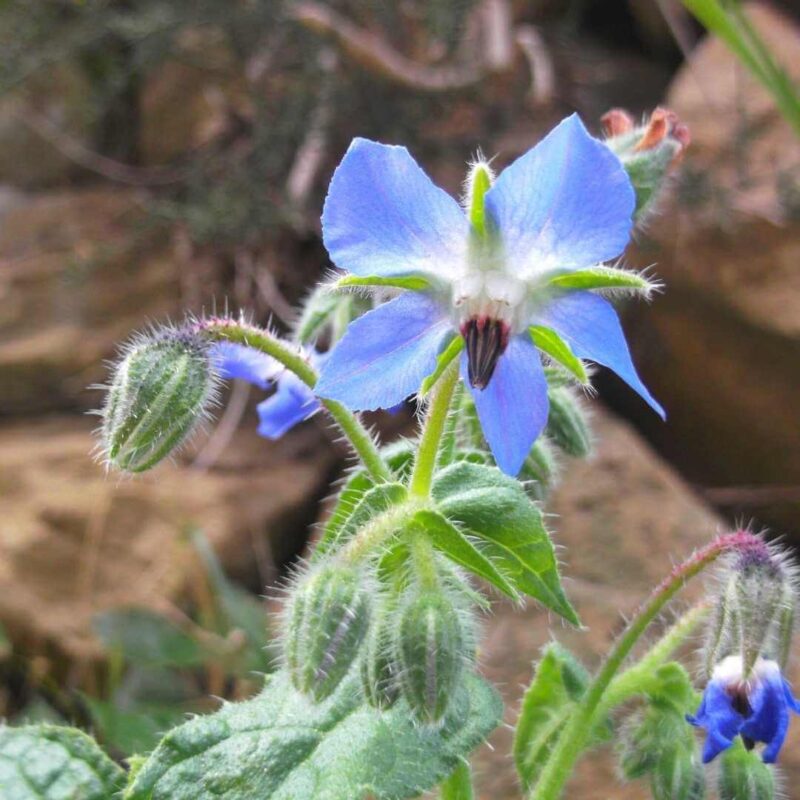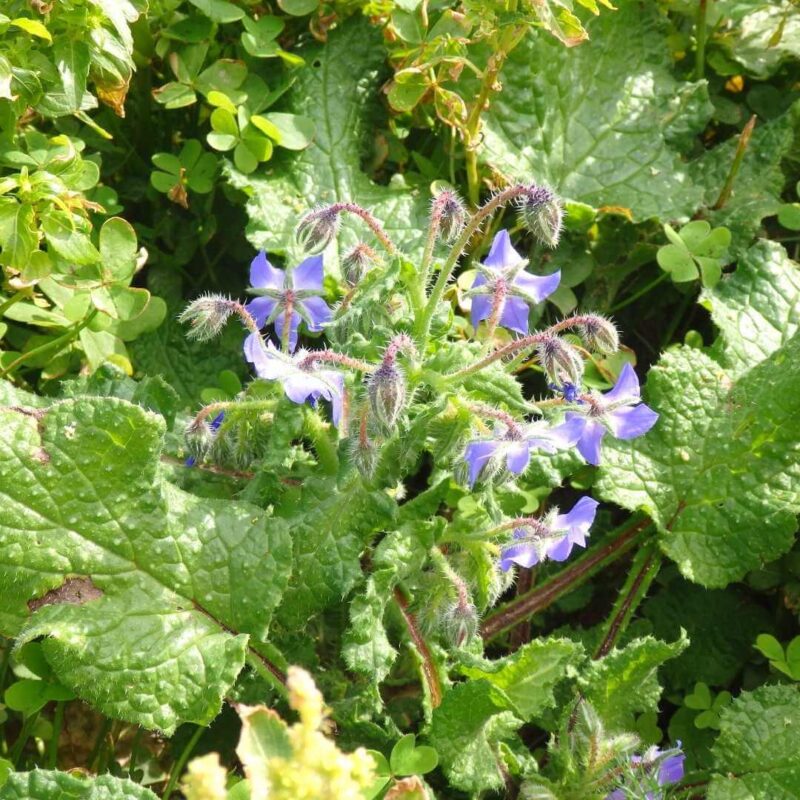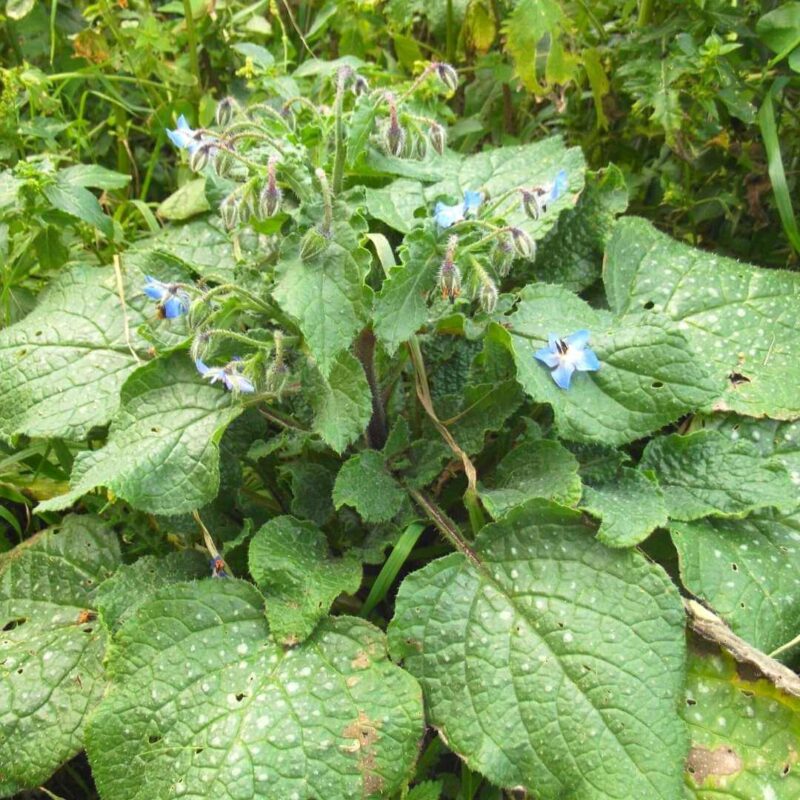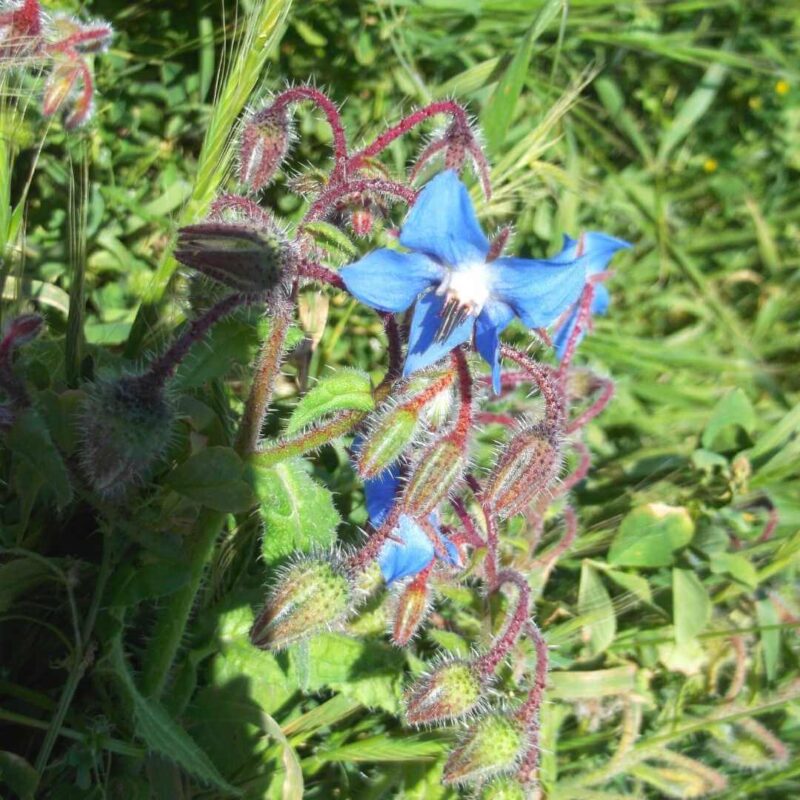Foraging Gozo. Sea Beet.
Sea Beet is found growing wild on Gozo and is a great alternative to chard.

We hope you enjoyed last month’s Weeds For Health Blog which spotlighted Asphodel. If you’ve been exploring Gozo over the winter you will have seen this evergreen in abundance decorating the cliff tops and rocky areas. Asphodel remains in flower until April, so there’s still time to enjoy this indigenous plant in bloom. Whilst walking keep your eyes peeled for bright blue star-shaped flowers; Borage, a native herb to the Mediterranean which is bursting with health properties. Learn how to make the most of Gozo’s natural medicine cabinet here.
Botanical name: Borago officinalis – L. Synonyms: Borago advena, Borago aspera, Borago hortensis Family name: Boraginaceae Maltese name: Fidloqqom Common names: Borage, Common borage, Cool-tankard, Starflower, Tailwort Meaning of name: Borago, from Latin, a corruption of corago, from cor, the heart, and ago, I bring, because of its cordial effect. Officinalis, from Latin, "of or belonging to an officina", the storeroom, from opifex (gen. opificis) "worker, maker, doer" (from opus "work") and -fex, -ficis, "one who does," (from facere "do, perform).

Borage is an annual growing to 0.6 m (2ft) by 0.3 m (1ft in). The whole plant is rough with white, stiff, prickly hairs. The round stems, about 45 centimetres, are branched, hollow and succulent; the leaves alternate, large, wrinkled, deep green, oval and pointed, 91 centimetres long or more, and about 45 centimetres broad, the lower ones stalked, with stiff, one-celled hairs on the upper surfaces and on the veins below, the margins entire, but wavy. The flowers, which terminate the cells, are bright blue and star-shaped, distinguished from those of every plant in this order by their prominent black anthers, which form a cone in the centre and have been described as their beauty spot.
On Gozo, Borage flowers from January to May. The fruit consists of four brownish-black nutlets.
The leaves are used as an adrenal tonic to balance and restore the health of the adrenal glands following periods of stress. Borage is well known for its soothing qualities and has been used to treat nervous conditions. Its natural sedative effects have been used for lifting the spirits and softening the nervous edge some people experience. Borage works well to ease the depression and mood swings often associated with menopause and menstrual cycles as well and is a nice alternative to traditional prescription medications.
A tea made from the leaves and flowers also promote lactation, stimulate the production of milk for breastfeeding mothers. Borage tea is also a good remedy for such digestive disturbances as gastritis and irritable bowel syndrome. It will also cure a hangover. It is of particular benefit during recovery from surgery or following steroid treatment. Minerals and vitamins are packed into the borage plant making it very nutritional. It is great for inflammation due to allergies and infection of the mucous membrane.
As an expectorant, it helps in loosening phlegm for coughs. Great for colds, flu and bronchitis, relieve fevers and promote sweating. Borage seed oil reduces cardiovascular reactivity to stress by reducing the systolic blood pressure and heart rate and by increased task performance. The oils are rich in linoleic acid and gamma-linolenic to help treat menstrual problems. It helps prevent inflammation of the gastrointestinal mucosa in cases of allergy.
Modern medical research has found that Borage oil contains Omega-3 and -6 fatty acids which are crucial for brain functions as well as growth and development. In the West, people typically don’t get enough Omega-3 fatty acids in their diets. These lift depression (as does Borage) and help our sexual health as well as general health. These fatty acids can stimulate hair growth, maintain bone health and regulate our metabolism.
A poultice of crushed Borage leaves will relieve insect bites and stings, reduce inflammation swelling and bruising and is also helpful for clearing up boils and rashes. Cover with a strip of cotton gauze to hold the poultice in place. The poultice is soothing and healing to skin inflammation, though the prickly hairs may be irritating. Borage oil is used in chronic skin conditions. It helps with skin clearing and lightening, promoting healthy skin growth. Used as an eyewash, Borage relieves irritation.
Celtic warriors drank wine flavoured with borage to give them courage in battle and many of the most noted herbalists throughout history have considered it a very effective anti-depressant.
Helena Szöllősy
Leaves – raw or cooked. They can be used as a pot-herb or be added to salads. They are also added whole as a flavouring to various drinks such as Pimms and wine-based drinks. The leaves are rich in potassium and calcium, they have a salty cucumber flavour. Very hairy, the whole leaves have an unpleasant feeling in the mouth and so they are best chopped up finely and added to other leaves when eaten in a salad. The leaves should always be used fresh because they lose their flavour and colour if dried.
Flowers – raw. They are used as a decorative garnish on salads and summer fruit drinks. The flowers are very nice, both to look at and to taste with a sweet slightly cucumber-like flavour. A refreshing tea is made from the leaves and/or the flowers. The dried stems are used for flavouring beverages. An edible blue dye can be obtained from the flowers. It is used to colour vinegar.
Seed – The seed yields 30% oil, 20% of which is gamma-linolenic acid.
Dye, oil, repellent. The growing plant is said to repel insects. A blue dye is obtained from the flowers. This turns pink on contact with acids.
Use with caution, there is an unconfirmed report of toxicity. Borage contains relatively small amounts of pyrrolizidine alkaloids that make the plant toxic to livestock and to humans. These compounds have a toxic effect on the liver and should not be used for prolonged periods of time or in case of tumours or pregnancy. The bristly hairs on the leaves and stems can cause dermatitis.


Borage is used in spells and incenses to bring courage and strength of character and to bring hope and lift the spirits in dark and difficult times. The herb can be used in rituals to explore the warrior’s path, the masculine, linear side of the personality and to make tea or oil used to consecrate weapons. The incense can be used to invoke various warrior Gods. The herb was held as sacred by the druids.
”Borage for courage”, Celtic warriors drank wine flavoured with borage to give them courage in battle and many of the most noted herbalists throughout history have considered it a very effective anti-depressant for the feeling of elation it induces. For courage, tuck a borage blossom in the pocket before any stressful situation, or drink a tea or glass of wine flavoured with borage leaves.
Borage has been used by Frenċ ta’ l-Gharb, the holy man of Gozo. Frenc Mercieca (1892-1967), popularly known as Frenc ta’ l-Għarb, a saintly ‘wise man’ who cured many people with a mix of medicinal herbs and prayer to Our Lady. He left doctors perplexed by his successes and his reputation spread rapidly throughout the Maltese Islands and even abroad. French Ta l-Gharb was and still is, considered as a Holy Man from the Island of Gozo, thousands of people used to go to him for cures and herbal remedies. He never maintained that he was a healer himself, but instead said that Jesus and the Virgin Mother performed the miracles with the sick.

Ingredients:
Method:
Keen to learn more? Click here to purchase the e-version of Weeds for Health on Gozo.
'I came across Heléna Szöllősy's book 'Weeds For Health On Gozo' in the summer of 2020 and was instantly intrigued as I have always been convinced, (or told countless times by my lovely mum) that everything on the planet is here for good reason. Walking the dog every day across this beautiful island, I often wonder what is growing beneath my feet and what special qualities these wild and free beings could bestow on me (or in fact, my dog.) I was aimlessly Googling (usual) one morning and came across a site that listed Heléna's book. I felt a pang of excitement, jumped out of my seat and shouted to my husband 'Look someone has written a book about weeds on Gozo!' He was thankful I wouldn't ask him anymore. So I tracked this genius down and asked her if she would share her expertise with GITH. Lucky for us all, she gracefully accepted.' Andrea Britton

Author and Images: Heléna Szöllősy.
Helena is an expert on the medicinal properties of plants having trained in Herbal Medicine and Naturopathy, specialising in Phytotherapy including Homeopathy, Aromatherapy, Apitherapy and Bach Flower Therapy.
Sea Beet is found growing wild on Gozo and is a great alternative to chard.
Did you know Wild Asparagus Is really good for your skin? You can find it on Gozo all year round.
Wild Artichokes Are found growing wild on Gozo and super healthy for the liver.
Small White Clover, found growing wild on Gozo and known to be lucky makes a great pudding!